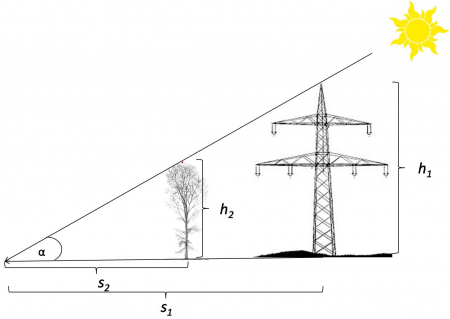Exercise : Measuring heights of trees outside the forest (TOF) in digital orthophotos (DOP)
From AWF-Wiki
(Difference between revisions)
(→Shadows in orthorectified remote sensing images) |
(→Shadows in orthorectified remote sensing images) |
||
| Line 3: | Line 3: | ||
A simple application of the intercept theorem in elementary geometry is to determine the height of a tree by measuring the shadow length. According to Fig. '''A''' the shadow length and the height of a man made object such as an overhead line tower was measured. If the lenght of a tree's shadow is known at the same time of the day we are able to compute .... | A simple application of the intercept theorem in elementary geometry is to determine the height of a tree by measuring the shadow length. According to Fig. '''A''' the shadow length and the height of a man made object such as an overhead line tower was measured. If the lenght of a tree's shadow is known at the same time of the day we are able to compute .... | ||
| + | |||
| + | We may also use trigonometry if we know the sun elevation or the angle alpha. The height of a tree is then computed .... | ||
==Estimating sun elevation== | ==Estimating sun elevation== | ||
Revision as of 17:05, 14 July 2014
Contents |
Shadows in orthorectified remote sensing images
A simple application of the intercept theorem in elementary geometry is to determine the height of a tree by measuring the shadow length. According to Fig. A the shadow length and the height of a man made object such as an overhead line tower was measured. If the lenght of a tree's shadow is known at the same time of the day we are able to compute ....
We may also use trigonometry if we know the sun elevation or the angle alpha. The height of a tree is then computed ....
